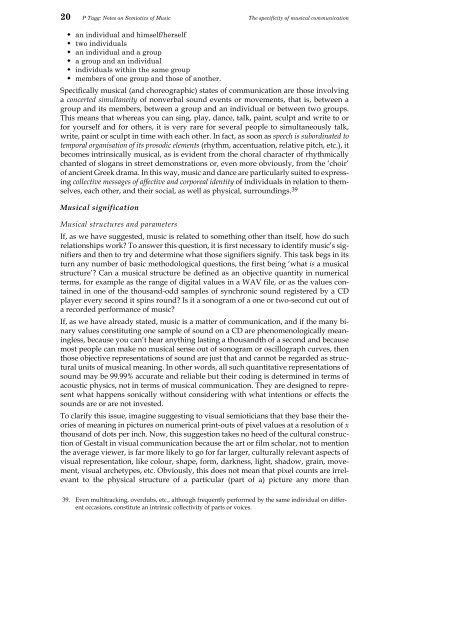Introductory notes to the Semiotics of Music - Philip Tagg's home page
Introductory notes to the Semiotics of Music - Philip Tagg's home page
Introductory notes to the Semiotics of Music - Philip Tagg's home page
Create successful ePaper yourself
Turn your PDF publications into a flip-book with our unique Google optimized e-Paper software.
20 P Tagg: Notes on <strong>Semiotics</strong> <strong>of</strong> <strong>Music</strong> The specificity <strong>of</strong> musical communication<br />
� an individual and himself/herself<br />
� two individuals<br />
� an individual and a group<br />
� a group and an individual<br />
� individuals within <strong>the</strong> same group<br />
� members <strong>of</strong> one group and those <strong>of</strong> ano<strong>the</strong>r.<br />
Specifically musical (and choreographic) states <strong>of</strong> communication are those involving<br />
a concerted simultaneity <strong>of</strong> nonverbal sound events or movements, that is, between a<br />
group and its members, between a group and an individual or between two groups.<br />
This means that whereas you can sing, play, dance, talk, paint, sculpt and write <strong>to</strong> or<br />
for yourself and for o<strong>the</strong>rs, it is very rare for several people <strong>to</strong> simultaneously talk,<br />
write, paint or sculpt in time with each o<strong>the</strong>r. In fact, as soon as speech is subordinated <strong>to</strong><br />
temporal organisation <strong>of</strong> its prosodic elements (rhythm, accentuation, relative pitch, etc.), it<br />
becomes intrinsically musical, as is evident from <strong>the</strong> choral character <strong>of</strong> rhythmically<br />
chanted <strong>of</strong> slogans in street demonstrations or, even more obviously, from <strong>the</strong> ‘choir’<br />
<strong>of</strong> ancient Greek drama. In this way, music and dance are particularly suited <strong>to</strong> expressing<br />
collective messages <strong>of</strong> affective and corporeal identity <strong>of</strong> individuals in relation <strong>to</strong> <strong>the</strong>mselves,<br />
each o<strong>the</strong>r, and <strong>the</strong>ir social, as well as physical, surroundings. 39<br />
<strong>Music</strong>al signification<br />
<strong>Music</strong>al structures and parameters<br />
If, as we have suggested, music is related <strong>to</strong> something o<strong>the</strong>r than itself, how do such<br />
relationships work? To answer this question, it is first necessary <strong>to</strong> identify music’s signifiers<br />
and <strong>the</strong>n <strong>to</strong> try and determine what those signifiers signify. This task begs in its<br />
turn any number <strong>of</strong> basic methodological questions, <strong>the</strong> first being ‘what is a musical<br />
structure’? Can a musical structure be defined as an objective quantity in numerical<br />
terms, for example as <strong>the</strong> range <strong>of</strong> digital values in a WAV file, or as <strong>the</strong> values contained<br />
in one <strong>of</strong> <strong>the</strong> thousand-odd samples <strong>of</strong> synchronic sound registered by a CD<br />
player every second it spins round? Is it a sonogram <strong>of</strong> a one or two-second cut out <strong>of</strong><br />
a recorded performance <strong>of</strong> music?<br />
If, as we have already stated, music is a matter <strong>of</strong> communication, and if <strong>the</strong> many binary<br />
values constituting one sample <strong>of</strong> sound on a CD are phenomenologically meaningless,<br />
because you can’t hear anything lasting a thousandth <strong>of</strong> a second and because<br />
most people can make no musical sense out <strong>of</strong> sonogram or oscillograph curves, <strong>the</strong>n<br />
those objective representations <strong>of</strong> sound are just that and cannot be regarded as structural<br />
units <strong>of</strong> musical meaning. In o<strong>the</strong>r words, all such quantitative representations <strong>of</strong><br />
sound may be 99.99% accurate and reliable but <strong>the</strong>ir coding is determined in terms <strong>of</strong><br />
acoustic physics, not in terms <strong>of</strong> musical communication. They are designed <strong>to</strong> represent<br />
what happens sonically without considering with what intentions or effects <strong>the</strong><br />
sounds are or are not invested.<br />
To clarify this issue, imagine suggesting <strong>to</strong> visual semioticians that <strong>the</strong>y base <strong>the</strong>ir <strong>the</strong>ories<br />
<strong>of</strong> meaning in pictures on numerical print-outs <strong>of</strong> pixel values at a resolution <strong>of</strong> x<br />
thousand <strong>of</strong> dots per inch. Now, this suggestion takes no heed <strong>of</strong> <strong>the</strong> cultural construction<br />
<strong>of</strong> Gestalt in visual communication because <strong>the</strong> art or film scholar, not <strong>to</strong> mention<br />
<strong>the</strong> average viewer, is far more likely <strong>to</strong> go for far larger, culturally relevant aspects <strong>of</strong><br />
visual representation, like colour, shape, form, darkness, light, shadow, grain, movement,<br />
visual archetypes, etc. Obviously, this does not mean that pixel counts are irrelevant<br />
<strong>to</strong> <strong>the</strong> physical structure <strong>of</strong> a particular (part <strong>of</strong> a) picture any more than<br />
39. Even multitracking, overdubs, etc., although frequently performed by <strong>the</strong> same individual on different<br />
occasions, constitute an intrinsic collectivity <strong>of</strong> parts or voices.














